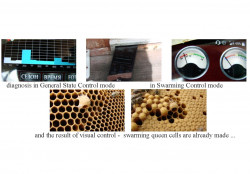Features of acoustic control of bees families. Diagnosis of swarming state according to the quantity of passive bees in the family.
Diagnosis of swarming state is based on the theory, that the basis of swarm is always a young bees, which are not involved in the works of the family. That is, passive bees. These bees are not ready to go on a flight for the honey, or there is no honey in nature, but they do not work inside the hive, too. Neither caring for the brood, no processing honey. So, it occur an imbalance in the family, provoking the bees to transition to the natural breeding process, or to swarming. Thus, the diagnostics of accumulation of passive bees in the family, is the basis of the method of diagnosing the state of swarming in bee families. So, that is exactly the point which diagnose Apivox Auditor in Swarming Control mode - accumulation of passive bees not engaged in the work and their excitement. But the question is just that - how our device diagnose it ! To say that these bees are passive, it is necessary to find active bees for comparison! And active bees just working with honey! Therefore, this recommendation suggests itself - check families for swarming state should be carried out in the "working time" that is, the day time when all the bees in the hive must work and passive bees should not be at all. At this time, the presence of passive bee says about the possible preparation of a bee society for swarming. Results, obtained by American scientists in course of their experiments, clearly show, that the largest peak of intensity of bee's signals during swarming period, occurs in approximately four or five days, before the queen will lay eggs in swarming queen cells, constructed by the bees. This time coincides with the foundation of future queen cells by the bees. All bees are excited. During this period, our device in Swarming Control mode, will show its first very strong warning. Further, in spite of some peaks of activity, there is a decrease in signal intensity, and at this time, our device shows the borderline state, being used in Swarming Control mode. But during all this period, General State Control mode will help us. It indicates the presence of passive bees in the bee society, preparing to become a swarm, and the excited state of the bees, which characterize pre-swarming period. Next warning in Swarming Control mode, our device will give us during the period of time, four or five days before swarm departure, when the first queen cell will be capped and the swarm will gather all its strength. The last warning will be issued during the period from about a day before the departure of the swarm, till the day of its departure. But, of course, no one is going to wait for beginning of swarming process, to start taking the necessary measures. In the USA in Oklahoma state, was developed and now is in use, very good method, accessible primarily to amateur beekeepers. Diagnostics of the pre-swarming condition of the bee family using APIVOX AUDITOR device, gives a permanent, good result. Our device signalize about beginning of swarming process on the first stage of building swarming queen cells by the bees. Normally, there are no larvae in these cells, yet. The number of drone brood is high, the honey-gathering activity is low. After receiving the diagnosis about pre-swarming condition in the family, the method of artificial swarming of professor Taranov is used. Using this method, we single out from the family all "passive" bees, which create a swarming situation, and turn them into a new family, where they are all start active work. The bees of maternal family will lay queen cells, or beekeeper can give them new fertile queen. Active work of the family of bees will stay completely preserved. The swarm condition will be completely eliminated. This method of professor Taranov was previously unknown in the USA, but now, in conjunction with our device, we hope, will win popularity among beekeepers. The reviews, so far, are very good...
Słowa kluczowe
Kraje
Austria, Australia, Canada, Switzerland, China, Denmark, France, Hong Kong, Hungary, Ireland, Israel, Italy, Netherlands, Norway, New Zealand, Romania, Sweden, Slovenia, Slovakia, United Kingdom, United States



